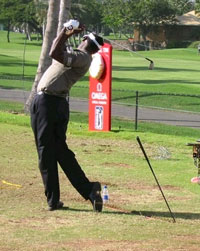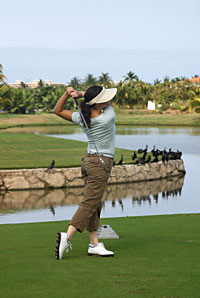 If you took up the game recently, sooner or later you will want to “hit the range”. Maybe you got to play your first round of golf and got hooked and now you want to learn how to do it right.
If you took up the game recently, sooner or later you will want to “hit the range”. Maybe you got to play your first round of golf and got hooked and now you want to learn how to do it right.
Maybe you’ve hit many bad shots in a row — then hit a great shot — then followed it up with a terrible shot.
You probably said to yourself, ‘Why can’t I hit that good shot everytime?’ Well welcome to the club.
The only way to get better is to practice and the best place to practice and learn the correct swing and how to hit the ball is on the driving range or practice facility.
By the way, what we mean by the range is not just that place where we buy a bucket of balls and hit full shots out into a big open area. The range is anyplace where we work on our game. It could be a driving range, a putting green, our back yard or our living room rug. It may be the mirror in our bedrooms or sitting in front of the TV watching The Golf Channel. All are places where we can develop and refine our skills.
For example, the golf grip can be worked on any time and any place. Just grab a club and learn to feel what the correct grip is like. It’s worth the effort because the golf grip is that important.
How To Practice
You’ve probably heard stories about how the pros, particularly Vijay Singh, practically live on the range and hit hundreds of balls a day. Those ads with Tiger Woods practicing in the rain are probably not so farfetched. The fact is, any good golfer has only become good by hitting thousands of balls and working hard on all aspects of their games.
If all this ball beating sounds like a lot of work and not much fun you’re not alone. Most of us “normal” golfers don’t have time or energy to go to the range everyday let alone once a week.
If you got hooked on golf by playing on a real course with all it’s manicured beauty, going to a big flat range with mats and yardage markers may not seem so appealing. It certainly doesn’t look or feel like a real course.
The reality is however, that to become a good golfer some “work” is required. And we all know that it’s worth it. Hitting a great shot is truly the pinnnacle moment in golf and those shots don’t happen without patience and practice.
Maybe those great shots feel like luck sometimes, but as Lee Trevino says, ‘the more I practice, the luckier I get.’
But going to the range doesn’t have to be all work. If you set some specific goals and figure out how to practice, the range can be almost as much fun as the course. Best of all, you’ll see your score get smaller and your enjoyment get bigger.
Goals On The Range
One of the keys to having fun on the range is to set some goals before you go. If you go to the range with the idea of just beating balls you might have fun but you may also be making things worse. Practicing bad habits ingrains those bad habits. Like Jack Nicklaus said in his classic instruction book, Golf My Way, “practice does not always make perfect, only perfect practice makes perfect.”
 Always Have a Target
Always Have a Target
One of the simple goals you can start with is to always have a target. Golf is above all a “target game”. We often forget this and start playing the “swing right” or “hit it far” game. Maybe those are fun games too, but to shoot a low number you’ve got to hit targets. My best rounds have always come when I was supremely focused on the target.
And when I talk about picking a target I’m not talking about some general area out on the range. Your target should be very specific and no larger that a yard or two wide. The more you can focus on a very specific target on all your golf shots the more you’ll see those really bad shots diminish.
A good practice range is one that has lots of targets and ideally a sense that you are hitting to a fairway or a green. That’s what works best.
My 11 Year Old Daughter’s Story
Here’s a little story about target focus. I went to the range with my 11 year old daughter one time and I said to her, “I’ll give you $100 if you can hit that 100 yard sign.” She’s a beginner I thought, and didn’t have a chance in hell of hitting that sign (neither did I for that matter), but she tried like heck and her swing naturally got better as she focused on trying to hit that sign. In fact, she insisted on using my Taylor Made big headed driver even though it was much too big for her, just to make sure she could hit it that far. She actully came within 10 yards of hitting it a couple of times. The real point was she was engrossed in doing something that would improve her game. And she had fun!
A few weeks later she asked me if we could go to the driving range again so she could try for that $100. Sure I said, thinking that I had tricked her into my goal of getting her interested in golf. Again she wanted to hit my driver and again she was hitting it in the general direction. Then she hit a shot that was a bit low, but headed straight for the 100 yard sign. It rolled and rolled and finally rolled right under the sign (it was about 4 ft wide). “Hey dad, you owe me $100. What happens if I do it again,” she said. Thinking she would never do it again, I said she would get another $100. About 20 minutes later, she hit a screamer that went straight for the sign, and bounced through it on the second hop. “Hey Dad, you owe me $200.”
Well she learned a good lesson that day and so did I. The lesson I learned is about target focus. If you put your mind completely on the target, trust your swing, then the body will find a way to get it there. Your body has the ability to hit the target if you let it.
Defining a Target
So how do you stay target focused on the range. It’s wide open and there is no “penalty” for a bad shot. The good thing about the typical driving range is there are usually lots of yardage markers and flags to aim at. Sometimes the yardages are even accurate (but don’t count on it). But there are usually no fairways and no greens that allow you to really visualize a “shot” to hit.
Now it’s time to use your imagination. To imagine a fairway I try to find two markers that are about 30-40 yards apart (about a typical fairway width). I define the middle of that “fairway” usually with another marker in the distance (or a tree or building). On my range down here in Florida, I’ve found the perfect practice spot. There’s a row of yardage markers that start at 100 yards and go straight out every 25 yards to 250 yards. I use that as the right side of my fairway. On the left there are 3 flags, roughly at 100, 150, and 200. There’s about 50 yards between them. In the distance is a flag right in the middle of the “fairway” at about 250 yards. It took awhile to find this spot but it works great. I sure hope they don’t move those markers around.
Mats versus Grass
Which is better to practice from…mats or grass? In the past, hitting off of mats was a real pain, literally and figuratively. But these days the mats have become so good, I practically always hit off mats for any shot that I would normally not tee up. Ideally you’d like to recreate the conditions on the course as much as possible. A good mat is often better than the grass on many driving ranges and closer to real course conditions. They insure that the lie you will get on each shot will be consistent. The real grass conditions on a range may be variable and with a lot of play sometimes very dug up. Too many inconsistent variables.
Tee shots are a little harder to recreate on a mat area. Making sure I recreate course conditions is I why I never use the rubber “tees” that are built into the mats. These are typically never the correct height and ball height on the peg is something that is very important to control. For wood shots the ball should be about half way above the top of the club. Thankfully you can buy replacements for those rubber tees that allow you to put an actual tee into it. These come a little closer to recreating real tee conditions. You can get those at your golf store or online here. Sometimes, if the range is slow I’ll stick a tee in the ground just in front of my mat. This allows you to still use the same targeting area you selected out on the range.
Your Alignment Station
One of the things you should always check when practicing is your alignment. It’s easy to believe we are aligned correctly when in reality our body may be way offline. Check your alignment by putting a club down or if you are using a square shaped mat, move the mat so it is set up “square” to your target. Always look from behind and draw an imaginary line between where you put the ball on the mat and the exact target. Remember your body will be parallel to the ball to hole target line, sort of like train tracks.
Your alignment station should also check for ball position. Make sure your ball position is correct and consistent for each club you are hitting, typically closer to your left foot for long irons and woods and closer to the middle of your stance for irons.
Hank Haney Talks About Creating An Alignment Station
How To Learn On The Range
It’s always good to have some idea of what you want to work on when you go to the range. You’ll find no shortage of suggestions if you have an instructor or a golf instruction book or from watching The Golf Channel. I’ve gotten most of golf learning from books. Some of the great classic books include the aforementioned, Golf My Way, by Jack Nicklaus, Tiger’s new book, How I Play Golf and Annika’s new book Golf Annika’s Way. There are literally hundreds of great books about golf (and I’ve read many of them). Here’s a list of some books I’ve found interesting.
Half the joy of the range is the discovery of what works for you and your particular swing. Enjoy the search as well as reaching the goal. Timothy Gellway in his great book the Inner Game of Golf, talks about playing golf in the Awareness Mode. Sensing your body and as many aspects of the swing motion as possible is critical to learning. Learning to feel where the club head is, sensing your head movement, watching how your upper body and lower body interact, are all parts of learning how to feel the swing.
As we learn to sense our swing we can experiment with little adjustments to that motion and begin to learn what works and what doesn’t. Learning the cause and effect elements of the golf swing is a matter of trial and error and experimentation. Like my daughter demonstrated, as children this learning process comes naturally. But as we get older it becomes harder and harder. It becomes more difficult to get out of our own way, turn off the ego and its judgements and trust the body to learn and do what comes naturally. As Gellway says in The Inner Game of Golf, learning to trust the inner self (Self 2) to learn and achieve the goal of hitting the target, is the key to learning in the awareness mode.
Practicing On The Course
A great way to practice is to get out on the course late in the day when no one is out there and hit a couple of balls on each shot. Play by yourself so you can hit extra balls and not be distracted by others.
Often when we go to play late in the day we are trying to get in 18 holes before dark and end up rushing and concentrating poorly. Why not take your time and play just 9 holes. Play games where you play 2 or 3 different balls on each hole, each competing against the other.
Take your time and really try and work on your game.
Here’s some games to try on the course…
- Play your best ball out of 3 balls on each shot. That will tell you what your potential best game could be.
- Play your worst ball out of each 3 shots. That will give you a real challenge and give you a chance to work on trouble shots.
Remember, scoring is less important then learning during these practice sessions on the course. Take advantage of these special opportunities.
My practice on the course has been some of the most productive. On the course I’m picking specific shots and dealing with real lies and wind conditions. If I don’t pull off a particular shot I can try it again until I get it right. This is the best way to build real confidence in your game and for specific shot situations.

